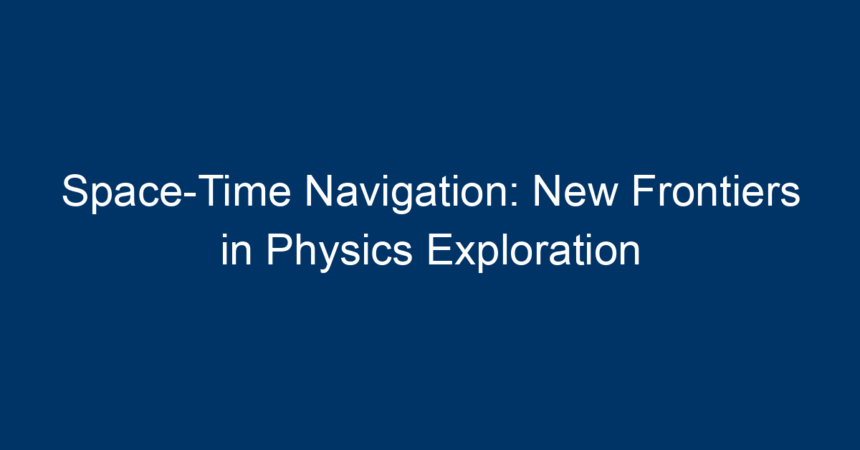Introduction
In the ever-evolving landscape of physics, few concepts have captured our imagination quite like space-time navigation. As we delve deeper into the universe’s mysteries, the idea of navigating through both space and time opens up a realm of possibilities that were once confined to the pages of science fiction. This article will explore the foundations of space-time navigation, its implications in modern physics, and the future it promises. With advancements in theoretical research and experimental technologies, we stand on the cusp of a new frontier in understanding our universe.
Understanding Space-Time
At its core, space-time is a concept that marries the three dimensions of space with the fourth dimension: time. Introduced by Albert Einstein in his theory of relativity, the space-time continuum proposes that the fabric of the universe is interconnected. Events that occur are not merely points in space but are also tied to their duration in time.
The Fabric of Space-Time
Space-time can be visualized as a four-dimensional "fabric" where every object has its coordinates in both space and time. This model allows for phenomena such as gravitational time dilation, where time passes at different rates under varying gravitational fields. Understanding this fabric is crucial for anyone looking to explore the nuances of space-time navigation.
The Role of Gravity
Gravity not only influences our motion through space but also curtails our flow through time. The stronger the gravitational pull, the slower time moves in that vicinity. This interplay between gravity and the flow of time raises fascinating questions about relativity and how we perceive navigation in a universe shaped by these forces.
Theoretical Foundations of Space-Time Navigation
Theories of Relativity
Einstein’s theories—both special and general relativity—serve as the backbone of our understanding of space-time navigation. Special relativity, which deals with inertial frames, introduces the idea that the speed of light is a constant. General relativity expands this by incorporating gravitational effects, demonstrating how massive objects can warp space-time itself.
Time Dilation
One of the most captivating concepts is time dilation, where time appears to move more slowly for objects in high-speed motion compared to those at rest. The implications of this phenomenon lead to a revolution in how we think about moving through time. If we could somehow navigate within this space-time framework, the potential for time travel or long-distance travel within the cosmos becomes tantalizingly feasible.
Quantum Mechanics and Space-Time
The realm of quantum mechanics, which describes the behavior of particles on a microscopic scale, introduces additional complexities. Quantum entanglement, for example, suggests that particles can be interconnected across vast distances instantaneously, seemingly defying the traditional constructs of space-time. This correlation could inspire new methods of space-time navigation, merging mechanics with astrophysics.
Practical Applications of Space-Time Navigation
Space Travel Innovations
With private enterprises and national space agencies pushing the boundaries of space exploration, understanding space-time navigation could lead to revolutionary rides through the cosmos. Advances in propulsion technology, such as the concept of warp drives, suggest that it might eventually be possible to bend space-time to propel spacecraft faster than light.
Warp Drives and Beyond
Theoretical models like the Alcubierre Drive propose a mechanism to expand and contract space-time, allowing vessels to effectively move through distances far exceeding what current technology permits. Although these remain in the domain of theoretical physics, continued exploration could make such ambitious concepts achievable.
Time Travel: Theoretical Implications
While traveling back in time remains a controversial subject, the foundational theories of space-time navigation provide a fertile ground for hypothetical discussions. Concepts such as wormholes—tunnels connecting different points in space-time—continue to intrigue scientists. If harnessed, these could revolutionize our understanding of temporal navigation.
Challenges and Considerations
Physical Limitations
While the theoretical aspects of space-time navigation are inspiring, we must acknowledge significant physical limitations. The laws of thermodynamics, quantum mechanics, and relativity present hurdles that may prove insurmountable. Even the prospect of creating a stable wormhole or warp drive relies on exotic matter—substances with negative energy density that have yet to be discovered.
Ethical Implications
As we ponder the prospects of navigating space-time, we must also consider the ethical implications. Would time travel disrupt the timeline? What consequences would arise from altering historical events? These questions necessitate a multidisciplinary approach, combining insights from philosophy, ethics, and science.
Current Research and Future Directions
Advances in Theoretical Physics
Research in space-time navigation is ongoing, with physicists probing the mysteries of the cosmos through groundbreaking experiments. From the detection of gravitational waves to experiments testing quantum properties, these endeavors shed light on the universe’s structure and our ability to navigate it.
Interdisciplinary Collaboration
The synthesis of ideas from various fields, including physics, engineering, and computer science, is essential for advancing our understanding of space-time navigation. Collaborations between theoretical physicists and engineers could lead to practical applications derived from these fascinating concepts.
Conclusion
As we stand at the precipice of a new era in physics, space-time navigation offers a promising avenue for exploration and innovation. While practical implementations may still be years away, the theoretical groundwork lays a strong foundation for future discoveries.
Actionable Insights
- Stay Informed: Follow advancements in physics and space exploration through reputable science channels.
- Engage in Discussions: Join forums or local groups focused on science and space exploration to share ideas and insights.
- Consider Studies in Physics: For those inspired by these concepts, pursuing academic studies in physics can contribute to future advancements in space-time navigation.
The fascination with exploring space and time is deeply intertwined with human curiosity and our quest for knowledge. As technology and understanding evolve, so too does our potential to navigate the universe in ways we can only begin to imagine. The journey of discovery continues, and who knows what new frontiers lie ahead?




